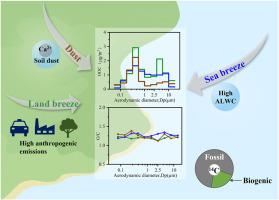中国东部沿海地区二级有机气溶胶的不同形成途径
IF 3.7
2区 环境科学与生态学
Q2 ENVIRONMENTAL SCIENCES
引用次数: 0
摘要
二次有机气溶胶(SOA)存在于广泛的粒径范围内,在区域空气污染和气候中起着至关重要的作用,但其在不同气象条件下的形成机制尚不清楚。本研究在中国东部沿海城市嘉兴采集了粒径分离的气溶胶样品(0.056 ~ 18 μm)。样本被分为陆风(LP)、海风(SP)和沙尘事件期(DP)。含氧有机气溶胶(OOAs)是各时期有机质的主要成分(65.9% ~ 81.6%)。放射性碳(14C)分析显示,化石来源的OOA占总OOC的78.1%。细态和粗态下OOA和O3的高相关性表明气相氧化在所有粒径中的重要作用,而细态SOA和Fe离子之间的特定关联表明水相在细态中有额外的贡献。在低潮期间,陆地气团相对较短的输送距离导致细颗粒和粗颗粒的氧化态较低,导致O/C值最低。相反,在SP过程中,气溶胶液态水的增加增强了SOA的形成,提高了粗颗粒中的O/C。在DP过程中,在长距离传输过程中发生了广泛的多代氧化,产生了更高的精细模式O/C。粗态OOA与Cl−和Ca2+呈正相关,表明与土壤粉尘有关。本研究强调了通过多种气团类型和不同粒径的SOA形成路径的复杂性,强调了将各种形成路径纳入大气模型以进行准确模拟和政策指导的必要性。本文章由计算机程序翻译,如有差异,请以英文原文为准。

Various formation pathways of size-resolved secondary organic aerosols at a coastal site in Eastern China
Secondary organic aerosol (SOA) exists across a broad particle size range plays a crucial role in regional air pollution and climate, yet its formation mechanisms under varying meteorological conditions remain poorly understood. In this study, size-segregated aerosol samples (0.056–18 μm) were collected in Jiaxing, a coastal city in eastern China. Samples were categorized into land breeze (LP), sea breeze (SP), and dust event periods (DP). Oxygenated organic aerosols (OOAs) were identified as the dominant component of organic matters across all periods (65.9–81.6 %). Radiocarbon (14C) analysis revealed that fossil-derived OOA exhibited a dominant contribution to total OOC (78.1 %). High correlations of OOA and O3 in both fine and coarse modes indicated the important role of gas-phase oxidation across all particle sizes, while a specific association between fine-mode SOA and Fe ions suggested an additional aqueous-phase contribution in the fine mode. During the LP, the relative short transport distance of land air masses resulted in lower oxidation states for both fine and coarse particles, leading to the lowest O/C values. In contrast, during the SP, increased aerosol liquid water enhanced SOA formation, elevating O/C in coarse particles. During the DP, extensive multi-generational oxidation occurred during long-range transport, yielding higher fine-mode O/C. The coarse-mode OOA was positively correlated with Cl− and Ca2+, implying heterogeneous formation related to soil dusts. This study highlights the complexity of SOA formation pathways through multiple air mass types and different particle sizes, underscoring the necessity to incorporate various formation pathways into atmospheric models for accurate simulations and policy guidance.
求助全文
通过发布文献求助,成功后即可免费获取论文全文。
去求助
来源期刊

Atmospheric Environment
环境科学-环境科学
CiteScore
9.40
自引率
8.00%
发文量
458
审稿时长
53 days
期刊介绍:
Atmospheric Environment has an open access mirror journal Atmospheric Environment: X, sharing the same aims and scope, editorial team, submission system and rigorous peer review.
Atmospheric Environment is the international journal for scientists in different disciplines related to atmospheric composition and its impacts. The journal publishes scientific articles with atmospheric relevance of emissions and depositions of gaseous and particulate compounds, chemical processes and physical effects in the atmosphere, as well as impacts of the changing atmospheric composition on human health, air quality, climate change, and ecosystems.
 求助内容:
求助内容: 应助结果提醒方式:
应助结果提醒方式:


